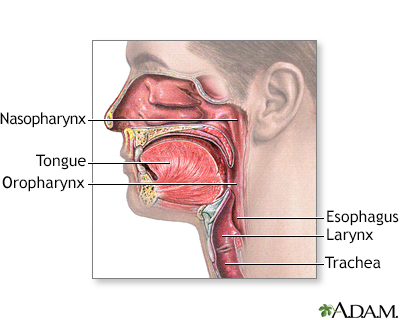Ludwig angina
Definition
Ludwig angina is an infection of the floor of the mouth under the tongue. It is due to a bacterial infection of the teeth or jaw.
Alternative Names
Submandibular space infection; Sublingual space infection
Causes
Ludwig angina is a type of bacterial infection that occurs in the floor of the mouth, under the tongue. It often develops after an infection of the roots of the teeth (such as tooth abscess) or a mouth injury.
This condition is uncommon in children.
Symptoms
The infected area swells quickly. This may block the airway or prevent you from swallowing saliva.
Symptoms include:
- Breathing difficulty
- Difficulty swallowing
- Drooling
- Unusual speech (sounds like the person has a "hot potato" in the mouth)
- Tongue swelling or protrusion of the tongue out of the mouth
- Fever
- Neck pain
- Tooth pain
- Neck swelling
- Redness of the neck
Other symptoms that may occur with this disease:
- Weakness, fatigue, excess tiredness
- Confusion or other mental changes
- Earache
Exams and Tests
Your health care provider will do an exam of your neck and head to look for redness and swelling of the upper neck, under the chin.
The swelling may reach to the floor of the mouth. Your tongue may be swollen or pushed up to the top of your mouth.
You may need a CT scan.
A sample of the fluid from the tissue may be sent to the lab to test for bacteria.
Treatment
If the swelling blocks the airway, you need to get emergency medical help right away. A breathing tube may needed to be placed through your mouth or nose and into the lungs to restore breathing. You may need to have surgery called a tracheostomy that creates an opening through the neck into the windpipe.
Antibiotics are given to fight the infection. They are most often given through a vein until symptoms go away. Antibiotics taken by mouth may be continued until tests show that the bacteria have gone away.
Dental treatment may be needed for tooth infections that cause Ludwig angina.
Surgery may be needed to drain fluids that are causing the swelling.
Outlook (Prognosis)
Ludwig angina can be life threatening. It can be cured with getting treatment to keep the airways open and taking antibiotic medicine.
Possible Complications
Complications may include:
- Airway blockage
- Generalized infection (sepsis)
- Septic shock
When to Contact a Medical Professional
Breathing difficulty is an emergency situation. Go to the emergency room or contact your local emergency number (such as 911) right away.
Contact your provider if you have symptoms of this condition, or if symptoms do not get better after treatment.
Prevention
Visit the dentist for regular checkups.
Treat symptoms of mouth or tooth infection right away.
Gallery

References
Chow AW. Infections of the oral cavity, neck, and head. In: Bennett JE, Dolin R, Blaser MJ, eds. Mandell, Douglas, and Bennett’s Principles and Practice of Infectious Diseases. 9th ed. Philadelphia, PA: Elsevier; 2020:chap 64.
Christian JM, Felts CB, Beckmann NA, Gillespie MB. Deep neck and odontogenic infections. In: Flint PW, Francis HW, Haughey BH, et al, eds. Cummings Otolaryngology: Head and Neck Surgery. 7th ed. Philadelphia, PA: Elsevier; 2021:chap 9.
Melio FR. Upper respiratory tract infections. In: Walls RM, Hockberger RS, Gausche-Hill M, eds. Rosen's Emergency Medicine: Concepts and Clinical Practice. 9th ed. Philadelphia, PA: Elsevier; 2018:chap 65.